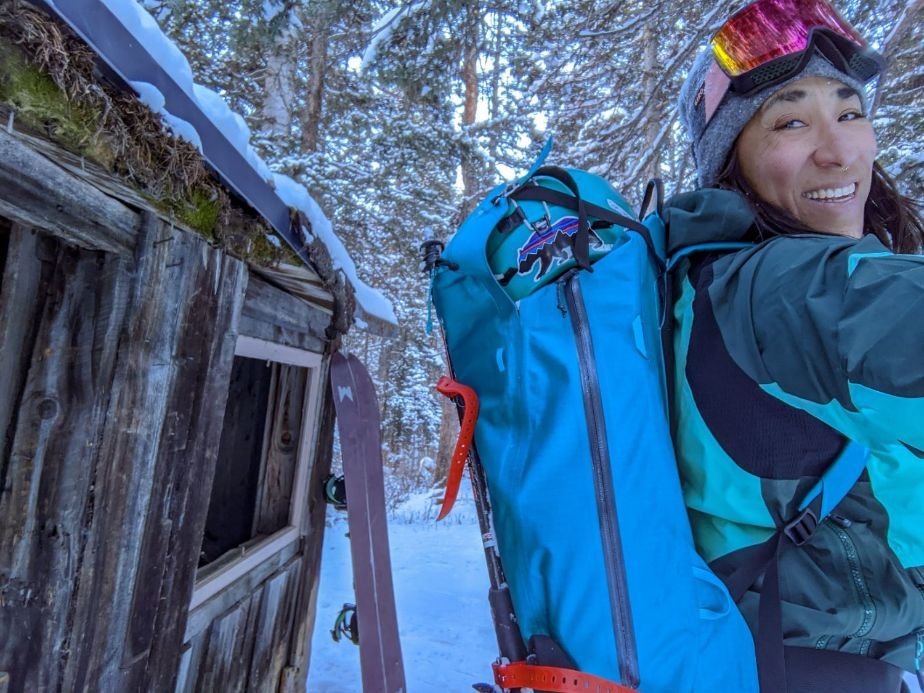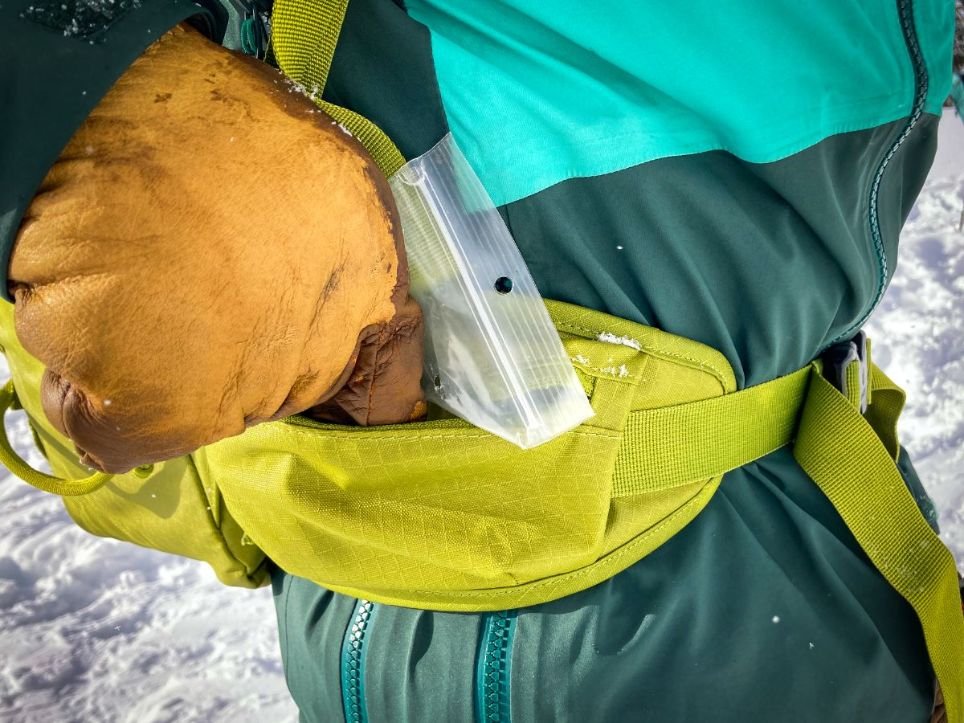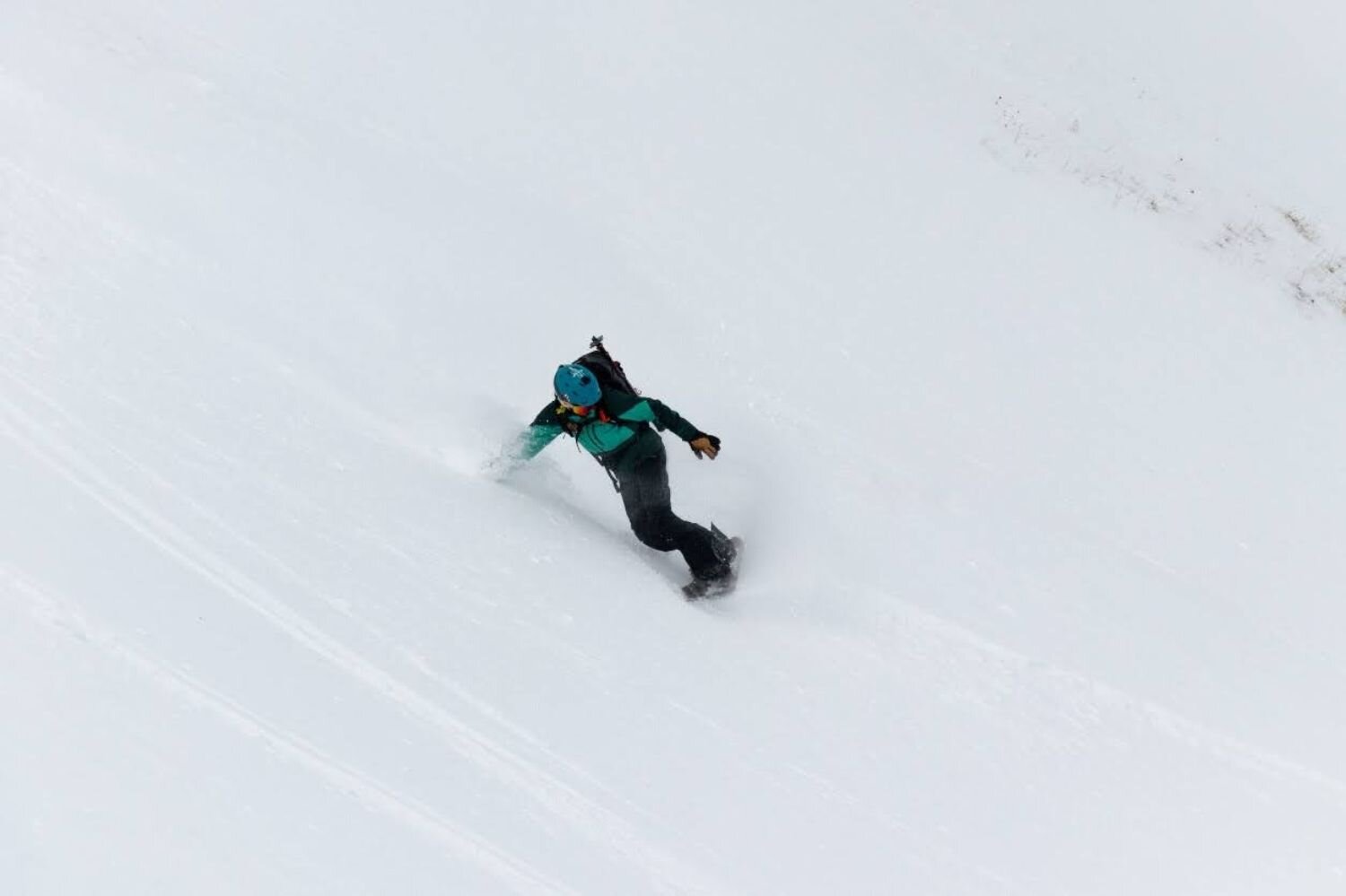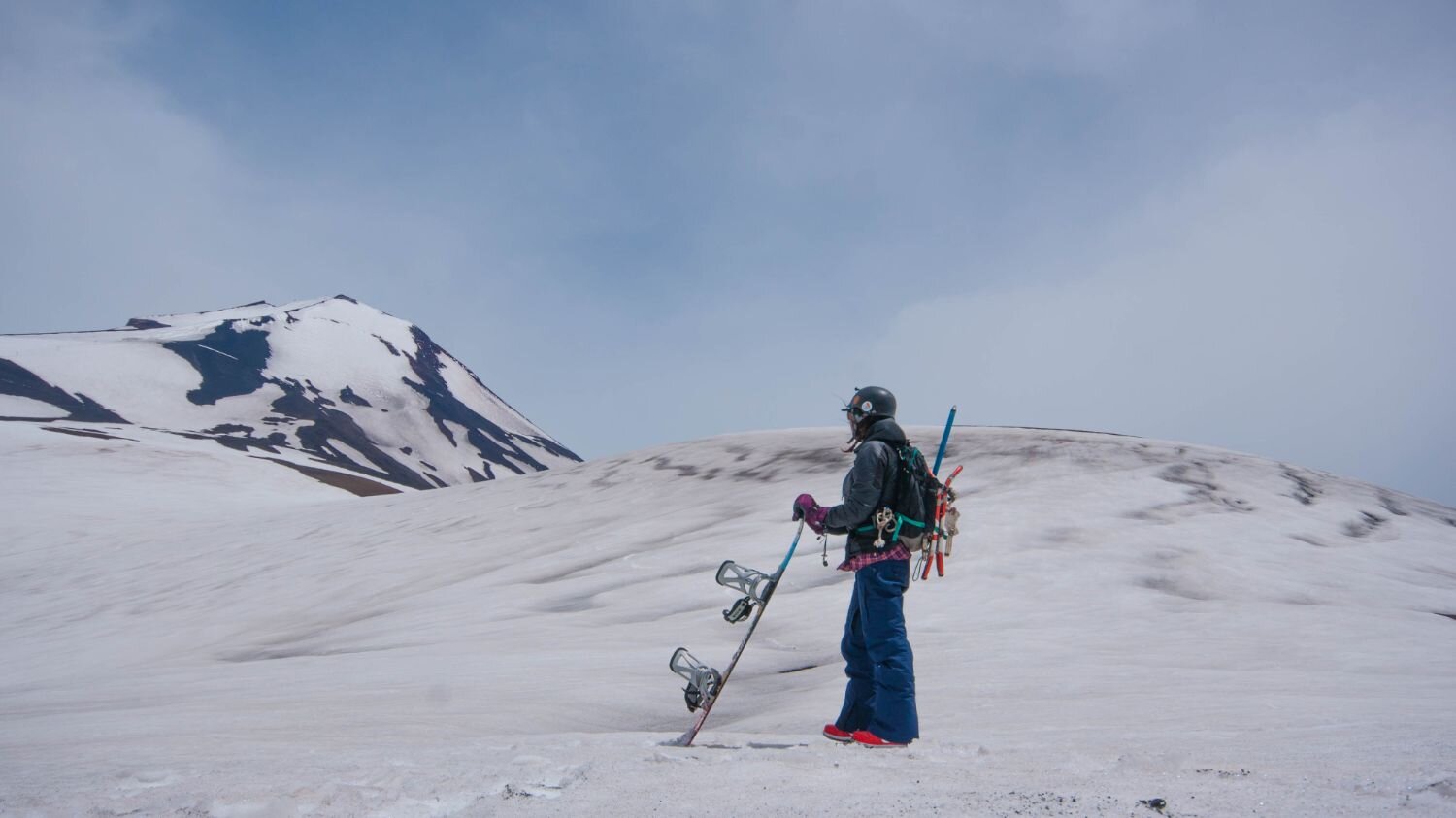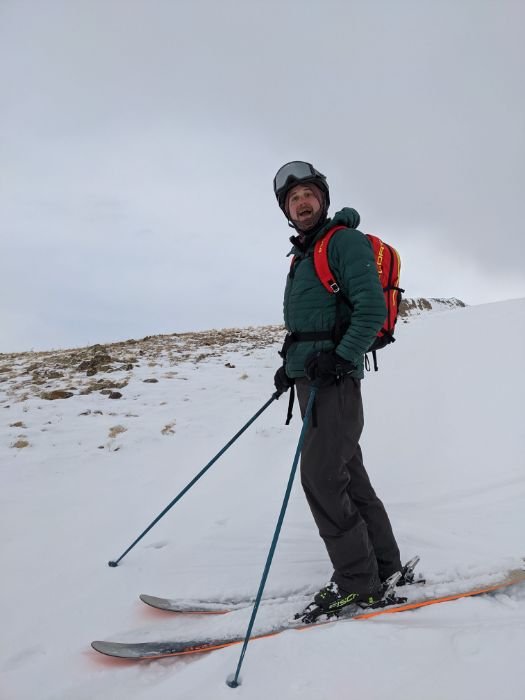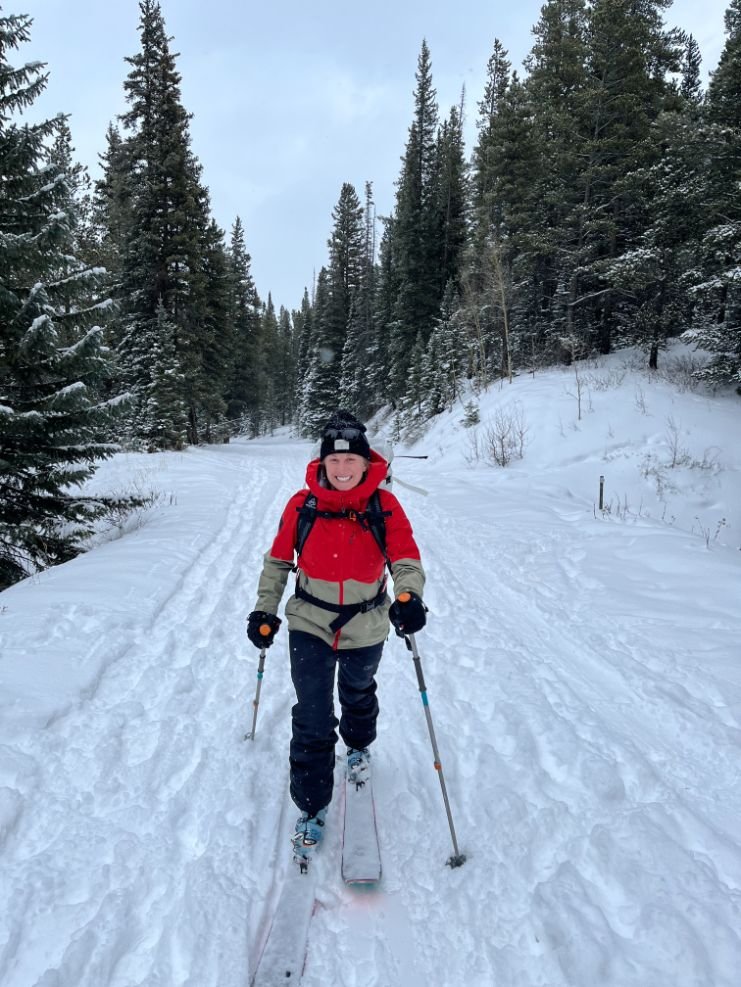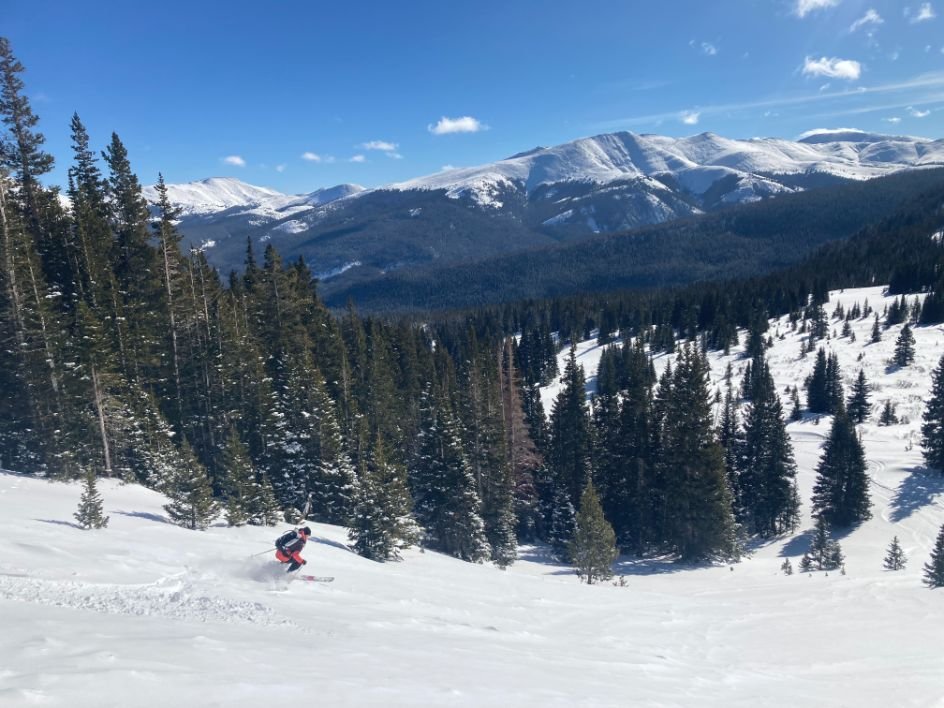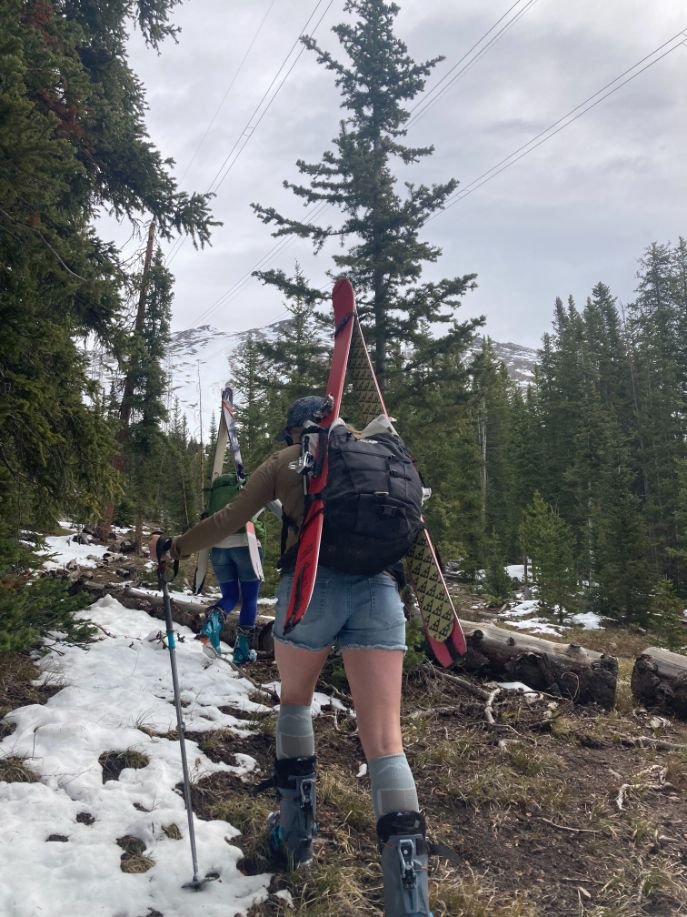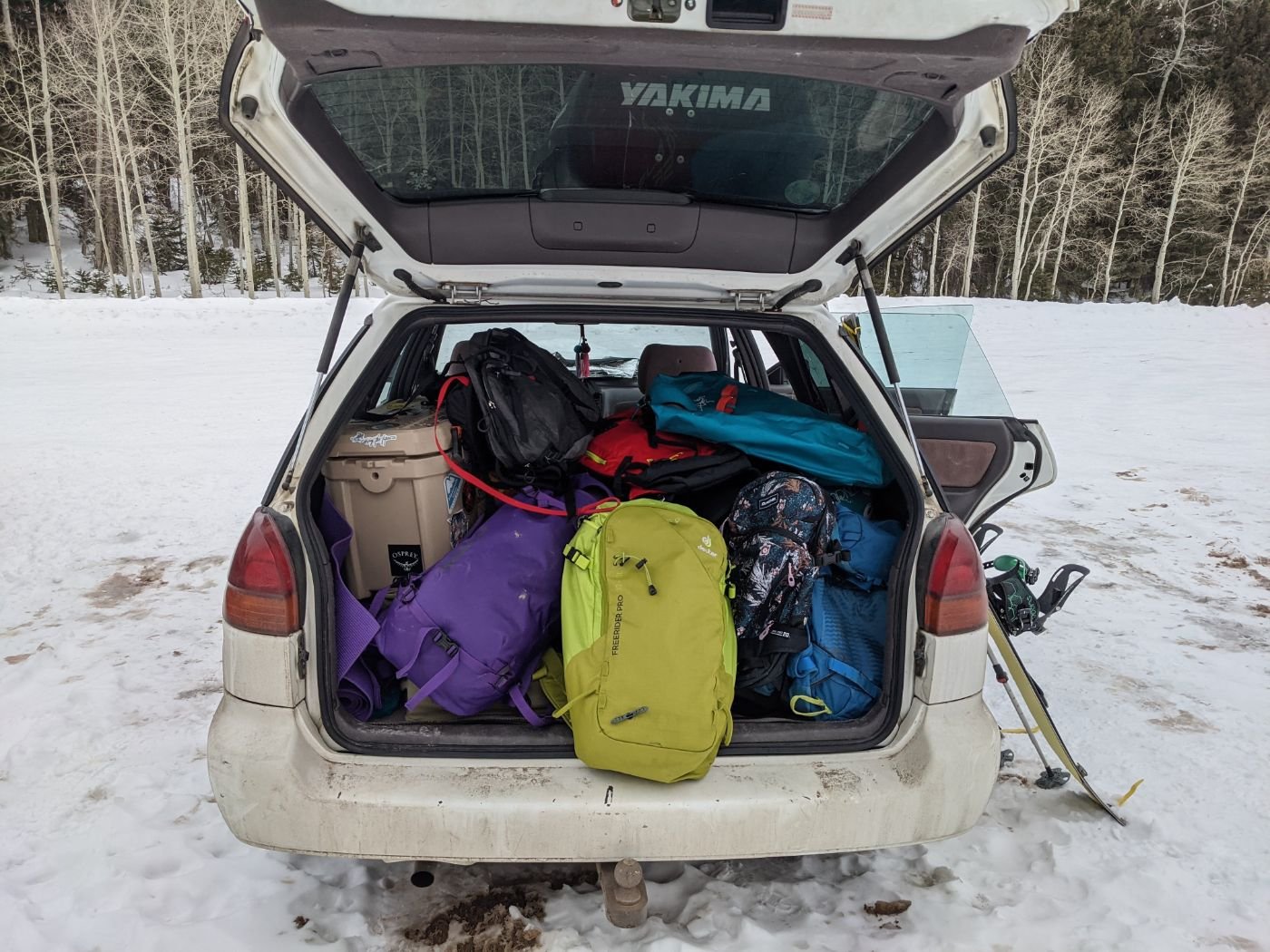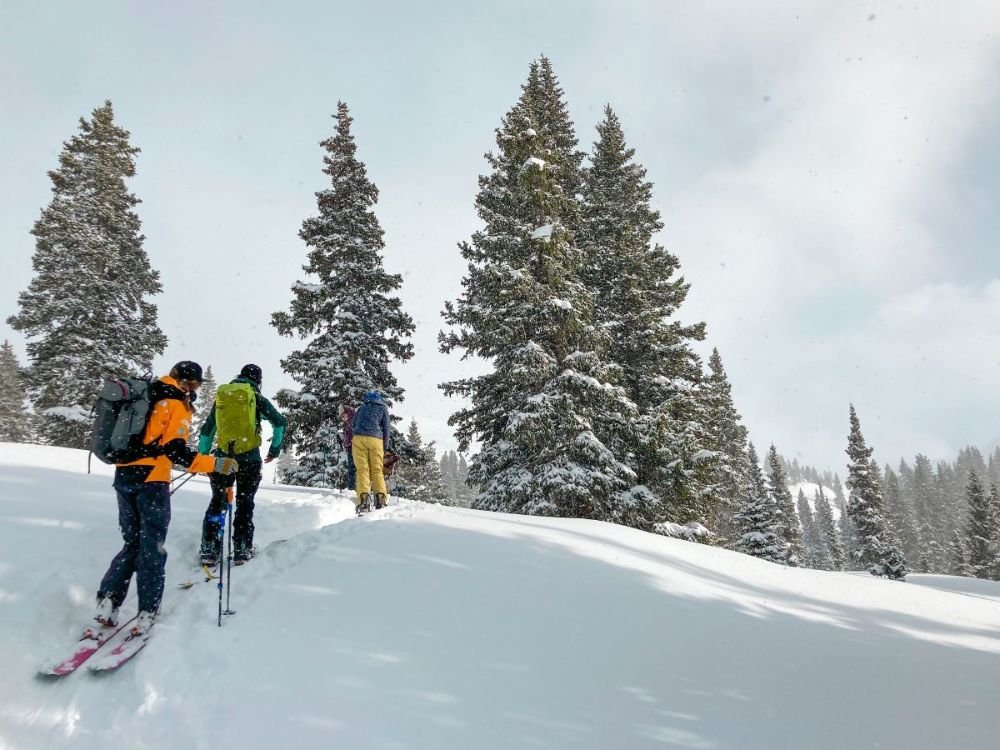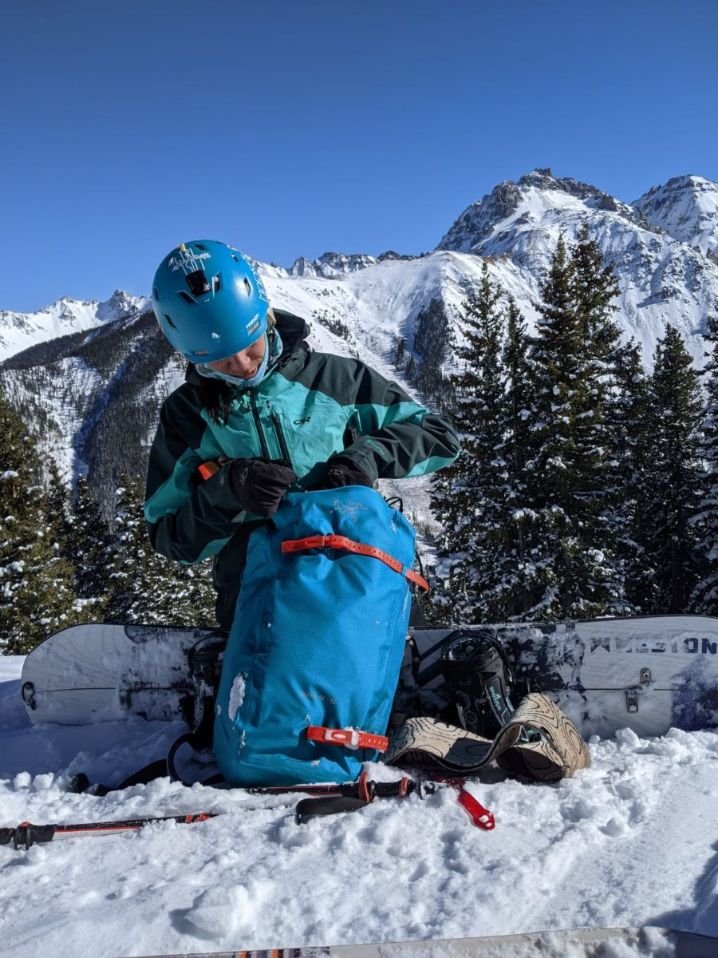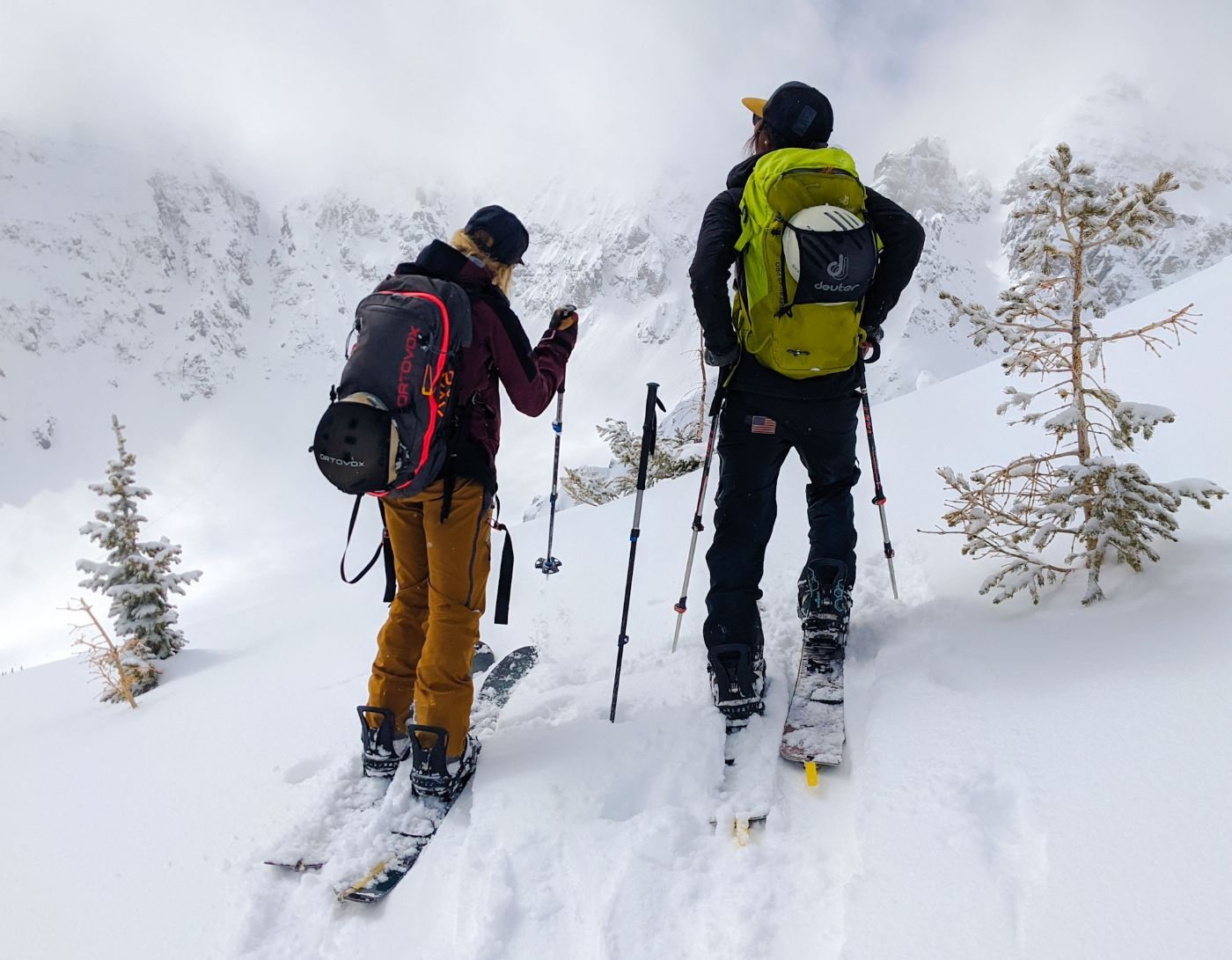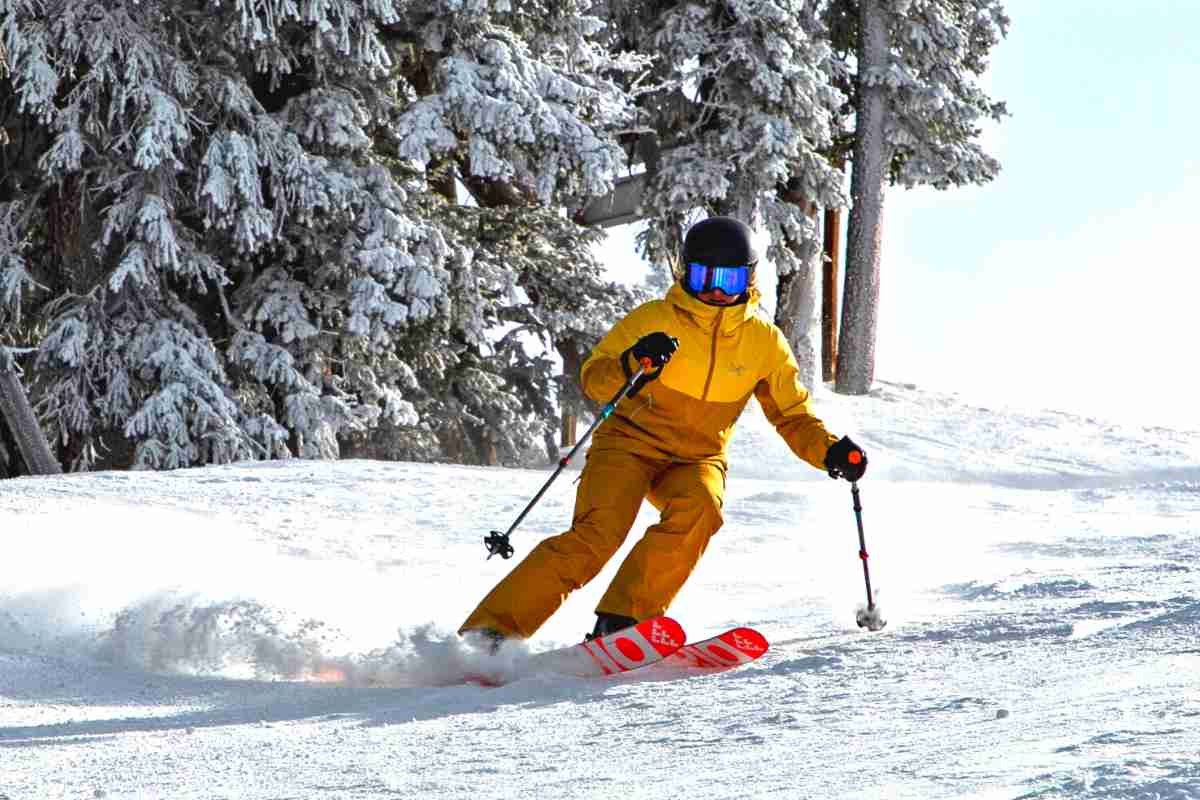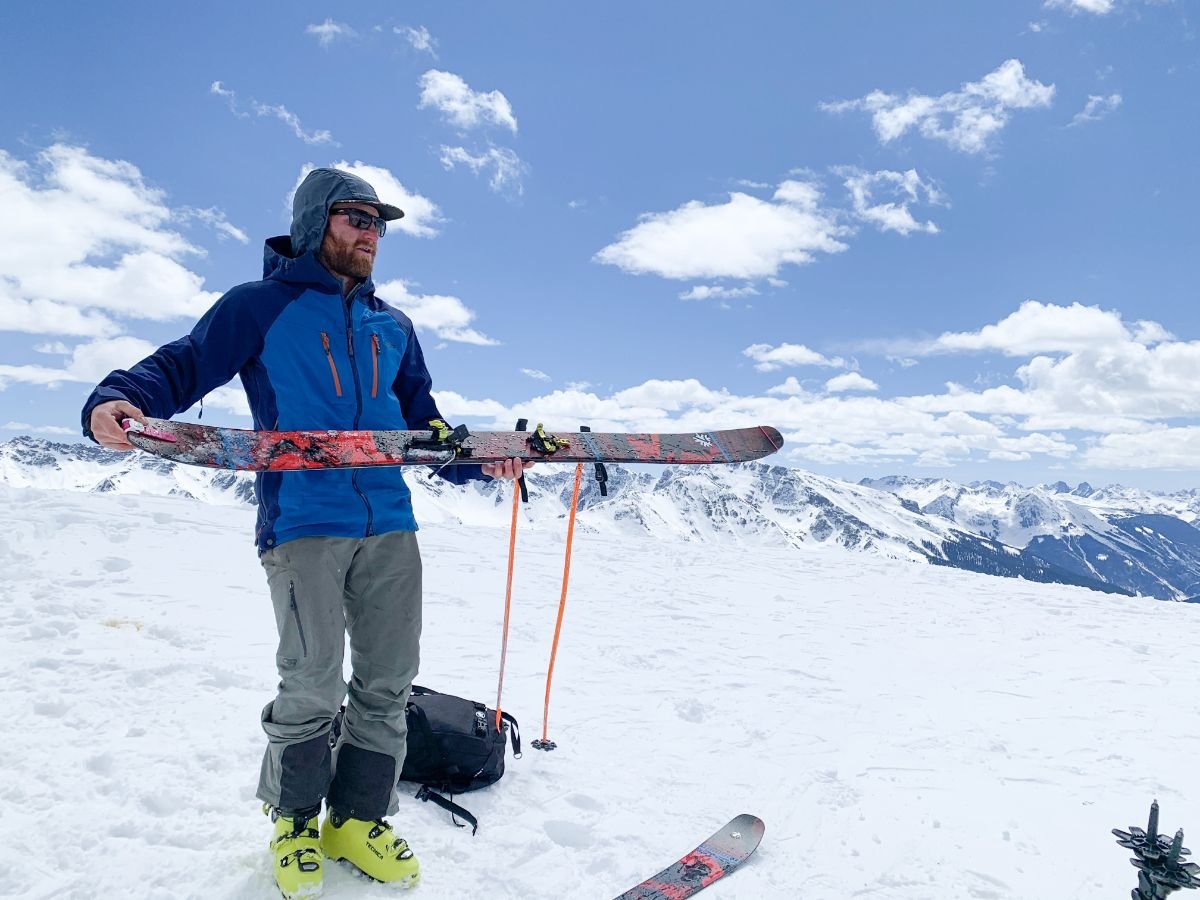Best Ski Backpacks of 2025
The Top Ski Touring Backpacks For All Experience Levels And Budgets
Updated November 8, 2024
Home > Gear Reviews > Ski & Snow
Whether you’re new to backcountry skiing or splitboarding or have been schussing smooth lines through powder for years, read on for a fresh take on the best ski backpacks that can take you from resort backcountry gates to mellow frontcountry lines to steep summit couloirs.
We researched and tested the top ski touring backpacks—both with and without avalanche bags—to accommodate skiers with different budgets and experience levels. You’ll need a ski touring pack wherever you’ll carry a shovel, probe, transceiver, and helmet.
With ski resorts being closed or having limited capacity over the past couple seasons, many learned just how great an outlet the backcountry in winter can be for stress relief, joy, and community.
Whether you’re a skier new to backcountry skiing and need a standard touring pack or are looking to add an airbag to your gear collection for skiing in certain seasons and conditions, we’ve got you covered with the best ski packs for the 2024/2025 season.
Disclaimer: An airbag and avalanche gear is not enough for a frontcountry or backcountry skier to safely travel in avalanche terrain. Learn the risks, invest in education, practice safe decision-making, and take a Level 1 avalanche course approved by the American Institute for Avalanche Research and Education prior to partaking in risky activities.
We create reader-supported, mission-driven objective gear reviews independently selected by our editors. This story may contain affiliate links, which help fund our website. When you click on the links to purchase gear, we may get a commission — without costing you an extra cent. Thank you for supporting our work and mission of outdoor coverage for every body! Learn more.
Backcountry Ski Packs ComparED
Men’s
| MEN'S SKI PACK | TREELINE AWARD | VOLUME(S) | WEIGHT(S) | SKI CARRY? | BOARD CARRY? | EXTERIOR POCKETS | AIR BAG? | MSRP(S)* |
|---|---|---|---|---|---|---|---|---|
| Deuter Freerider 30 | Best Overall Read review |
30 L | 2.2 lbs | Yes | Yes | 4 | No | $165 |
| Osprey Soelden Pro 32 | Best Avalanche Airbag Read review |
32 L | 6.4 lbs | Yes | Yes | 3 | Yes | $1,400 |
| Osprey Kamber | Best for Heavy Loads Read review |
20 L/ 30 L | 2.39 lbs/ 3.41 lbs | Yes | Yes | 4 | No | $180/ $210 |
| DAKINE Heli Pro Backpack | Best Resort Ski Pack Read review |
20 L/ 24 L | 2.12 lbs/ 2.36 lbs | Yes | Yes | 3 | No | $120/ $140 |
| Backcountry Access Float Avalanche Airbag 2.0 | Best Budget Airbag Read review |
12/ 22/ 32/ 42 L | 6 - 7.1 lbs | Yes | Yes | 4 | Yes | $500 - $750 |
Women's
| WOMEN'S SKI PACK | TREELINE AWARD | VOLUME(S) | WEIGHT(S) | SKI CARRY? | BOARD CARRY? | EXTERIOR POCKETS | AIR BAG? | MSRP(S)* |
|---|---|---|---|---|---|---|---|---|
| Deuter Freerider 28 SL | Best Overall Read review |
28 L | 2.16 lbs | Yes | Yes | 4 | No | $165 |
| Osprey Sopris Pro 30 | Best Avalanche Airbag Read review |
30 L | 6.2 lbs | Yes | Yes | 3 | Yes | $1,400 |
| Osprey Kresta | Best for Heavy Loads Read review |
20 L/ 30 L | 2.39 lbs/ 3.2 lbs | Yes | Yes | 4 | No | $180/ $210 |
| DAKINE Heli Pro Backpack | Best Resort Ski Pack Read review |
20 L/ 24 L | 1.78 lbs/ 1.89 lbs | Yes | Yes | 3 | No | $120/ $140 |
| Backcountry Access Float Avalanche Airbag 2.0 | Best Budget Airbag Read review |
12/ 22/ 32/ 42 L | 6 - 7.1 lbs | Yes | Yes | 4 | Yes | $500 - $750 |
* Prices reflect MSRP and are subject to change. We note any discounts we see on our Deals page, which is updated daily.
The Best Ski Backpacks
Best Overall Ski Pack: Deuter FREERIDER
Best for: Ski touring, ski mountaineering
Volumes available: 30 L (men’s), 28 L (women’s)
Weight: 2.2 lb
Airbag: No
Ski Carry/Snowboard carry: Yes/Yes
Back panel: Semi-rigid
Hydration compatible: Yes
Ice tool carry: Yes
Warranty: Lifetime repairs via Deuter Promise
Pockets: 4 + main compartment
What we liked: Comfortable padding, even for a lightweight pack, pockets, eco-friendly, lifetime warranty, excellent organization
What we didn't like: Could be better at holding a helmet
We think the Deuter Freerider is the best overall ski pack—the best daily driver for frequent use. We tested the Freerider 28 SL, which is the women’s-specific version, backcountry skiing and ski touring throughout Colorado's high mountains in varied terrain. We found the pack refined, feature-rich, no-fuss, and lightweight.
We found the Freerider ideal for medium length days or mellow tours. Although it is hard to find, they do make a Freerider Pro version that has an expandable roll-top, giving it up to 10 more liters’ capacity. This would be nice for longer days or multi-day hut trips.
We could carry the pack in the following combinations: vertical snowboard, standard A-frame, and diagonal ski carry, too.
COMPARE PRICES OF THE Deuter Freerider
Men's
Women's
The author testing the Deuter Freerider ski pack, finding it incredibly comfortable with excellent pocket organization.
We liked that the Freerider includes a standard avalanche safety pocket, plus a fleece-lined ski goggle pouch and inner pocket (just like the Osprey Kamber/Kresta, see below). Organization and pocket quality are big criteria for us in a ski pack, and Deuter went above and beyond here.
In fact, one Outside reviewer called this pack “a neat freak’s dream.” Yet even with all its organization, it only weighs 2.2 lbs, making it more than a pound lighter than its closest competitor, the Osprey Kamber/Kresta 40.
Just like the packs that sister company Ortovox makes, the Freerider refined the details, giving you a hyper-dialed ski touring pack while sacrificing practically nothing in terms of weight or style.
We found the Freerider ultra-comfortable even though its padding is lighter-weight. The Freerider does this by using what they call a Vari Flex system. The end result is there is extra mobility with hip fins. Lily Krass from Powder Magazine says that the "wiggle room with the waist belt … is definitely noticeable while bootpacking or skiing anything technical."
Dani Reyes-Acosta found the Deuter Freerider SL to be a ski touring and snowboarding backpack that’s versatile for big days and milder tours as well.
Our only complaint with the Deuter Freerider is that it doesn't hold a ski helmet that well. You might consider adding a separate helmet holder—a mini "hammock" that attaches to a pack.
Close up of the generous pockets on the Deuter Freerider ski pack.
We also like its sustainability because it comes with Lifetime repairs via the Deuter Promise.
The icing on the cake? This year’s Freerider packs are PFC-free and use a new more environmentally friendly Durable Water Repellent (DWR) treatment.
The Freerider’s high-performance materials with PFC-free and dirt- and water-repellent impregnation mean that you don’t have to worry about giving up on great gear for the sake of the environment. Maybe we really can have nice things after all.
See our most popular winter gear articles in our Snow Gear Guide:
Best Avalanche Airbag: Osprey Soelden Pro / Sopris Pro
Best for: Ski touring, ski mountaineering
Volume: 34 L (men’s), 32 L (women’s)
Weight: 6.4 lbs (men’s), 6.2 lbs (women’s)
Airbag: Yes, Alpride E2 System
Ski carry/ snowboard carry: Yes/Yes
Back panel: EVA foam
Hydration compatible: Yes
Ice axe carry: Yes
Warranty: 5 years
Pockets: Avalanche safety kit pocket, shovel handle, probe sleeves, hipbelt pocket, goggles pocket, internal pocket, sled carry attachment loops, GPS internal carry with mic attachment points, helmet carry
What we liked: Comfort, durability, organization, well-made, lifetime warranty, ease of using safety devices
What we didn't like: Price, weight
The best overall avalanche airbag is the Soelden Pro (men’s) and Sopris Pro (women’s). A good avalanche airbag pack should have more than just the airbag—it should have the features you want in any ski pack. Osprey checked the boxes for comfort, durability, and well-thought-out pockets. And its airbag system was easy to use and instilled confidence in the Alpride E2 system.
Compare prices of the Osprey Soelden Pro / Sopris Pro
Men's
Women's
Treeline Review writer Dani Reyes-Acosta backcountry skiing in the Osprey Soelden ski backpack in the San Juan mountains of Colorado. Photo courtesy Dani Reyes-Acosta.
The Alpride E2 system and Jetforce system differ in several ways; importantly, the E1 system is “not sensitive to lower temperatures, [since it’s powered off a supercapacitor instead of a lithium-ion battery,] meaning you get the same performance from -30°C to +40°C.”
Dani Reyes-Acosta showing the suitcase style zip on the Osprey Sopris Pro ski backpack.
Touring in historically sketchy snowpack in the San Juans, I felt safe wearing the Osprey Sopris Pro. The leg strap and easy trigger pull gave me the peace of mind I wanted when conditions weren’t ideal.
Still, as we discuss below, using an airbag shouldn’t influence your decision-making. Read our article on Backcountry Skiing Skills and Avalanche Safety Gear List for more on making safe decisions.
Like all Osprey bags, the Sopris Pro carried well in spite of its 6.2 lb weight. I love the hip belt pocket, pack ruggedness, helmet carry, and easily recharged battery.
I missed having a goggle pocket and did not love the suitcase-style zip open. (That said, I do have friends who DO love the different zip-open; it could just take some getting used to.)
Author Dani Reyes-Acosta snowboards on a beautiful descent wearing Osprey Sopris Pro avalanche ski pack. Photo by Nate-DeCremier
Osprey makes rugged packs, and the Sopris Pro is no different from its many other quality offerings.
What sets this electronic avalanche pack apart from other Osprey models is its more minimalist approach to organization and fabrication—both good things when it comes to saving weight and moving fast through the mountains.
Best for: Touring, ski mountaineering
Volumes available: 20 L, 30 L
Weight: 2.4 and 3.2 lbs (women’s), 2.4 and 3.4 lbs (men’s)
Airbag: No
Ski Carry/Snowboard carry: Yes, also snowshoe compatible
Back panel: Semi-rigid
Hydration compatible: Yes
Ice tool carry: Yes
Warranty: Lifetime—All Mighty Guarantee
Pockets: 4+main compartment
What we liked: well made, can carry many types of equipment comfortably, lifetime warranty
What we didn't like: trickier to pack skis than other packs, difficult to carry poles
Osprey packs are known for their durability, comfort, and ease of use. The Osprey men’s Kamber and women’s Kresta are no different; I used my Kamber for 5 seasons and never had a single complaint. Across the Sierra Nevada, Tetons, and San Juans, my Kamber didn’t just easily and comfortably stow all my necessary ski gear (and then some) — it also set a baseline for excellence in what makes a backpack.
First, the carry options. The Kamber/Kresta accommodates nearly every ski and snowboard carry option including vertical, A-frame, diagonal, and horizontal/vertical snowboard carry with smartly reinforced contact points to protect from sharp edges. This is an improvement against earlier models where the A-frame and diagonal carry were not supported.
As a splitboarder, I think the way a pack carries is a big deal. You will be accessing your board in high-consequence places like exposed, windy ridges or anywhere in avalanche terrain. You want your pack to carry in a predictable way.
Compare Prices Of The Osprey Kresta/Kamber
Women's
Men's
Dani Reyes-Acosta and a friend carrying the Osprey Kresta ski backpack for heavier loads and days where the mountain calls for more gear.
With a reinforced board buckle and compression straps, plus wide nylon webbing to secure your setup, carrying your skis or snowboard (or yes, even snowshoes) has never been easier.
Osprey paid attention to detail in this pack, giving users features like glove-friendly compartments, stashables like tool loops and helmet carry, and a very easily accessible back compartment and snow safety pocket.
I personally love that the brain has TWO pockets and can be detached to save weight or cut down on pack size. It has a goggle pocket on the top that is big enough to fit other essentials such as a phone, a snack, or even a very light layer.
The Osprey Kamber has room for a lot of gear. Here, the author lays out all her gear that fit inside her Kresta. Photo courtesy Dani Reyes-Acosta
The suspension on this beast-friendly pack means that even when it’s fully loaded, the wearer can comfortably break trail in even deep powder snow (see below). Yet, importantly, the Kamber and Kresta feature a 1.2mm HDPE (thick, lightweight plastic) framesheet and frame that resist bending.
The Kamber/Kresta is also available in a 20 L volume for folks who want a lighter pack. Unfortunately, the 32L and 42L, two capacities that were previously available, are no longer on Osprey website, though you may be able to find them at third-party stores.
The Osprey Kresta pack served me well over the years and can fit a variety of backcountry users well. My favorite feature? The All Mighty Guarantee means Osprey will repair any damage or defect, regardless of when you bought it—and free of charge—for the life of the product.
Now that’s something I can believe in.
BEST RESORT SKI BACKPACK: DAKINE HELI PRO
Best for: Resort skiing, day touring
Volumes available: 20 L, 24 L
Weight: 1.8 and 1.9 lbs (women’s), 2.1 and 2.4 lbs (men’s)
Airbag: No
Ski Carry/Snowboard carry: Yes/Yes
Back panel: Semi-rigid
Hydration compatible: Yes
Ice axe carry: Yes
Warranty: Limited Lifetime Warranty
Pockets: 4+main compartment
What we liked: Ease of use for lift-accessed backcountry or laps at a ski resort, price, organization, made of recycled material
What we didn't like: Limited volume
The DAKINE Heli Pro Backpack isn’t just for heli drops: it’s also a great pack for anyone just learning about lift-accessed backcountry (also known as “sidecountry”), splitting ski days with workdays, or just ripping laps at a ski resort.
The multi-function Heli Pro pack offers the basics for resort-based backcountry users. A snow safety pouch holds avalanche gear like a shovel and probe, side-straps convert to front-board carry for either skis or snowboards, and the internal hydration sleeve also doubles as a laptop sleeve.
This pack also features a sunglass/goggle pocket, external quick stash pocket, and internal mesh pocket for days when carrying a few snacks and extras at the resort is key. These niceties set this pack apart from other non-snow packs since features like glove-friendly zipper pulls and snow-shedding recycled polyester fabric mean users can quickly and easily access their necessities while on the lift or exiting backcountry gates.
Compare Prices Of The Dakine Heli PRO 20L
Women's
Men's
Compare Prices Of The Dakine Heli PRO 24L
Women's
Men's
Author Dani Reyes-Acosta at Lonquimay testing the DAKINE Heli Pro. Photo courtesy Dani Reyes-Acosta.
Reviewers at evo.com commented: “this is a very nice pack for carrying an extra layer, first aid kit and snacks around the resort” at the same time as saying this pack was “good for the resort, bad for the backcountry.”
With eight seasons of backcountry travel under my belt, I’ve found that I need my backcountry backpack needs to be able to carry at least 30L of essentials. At 20L and 24L, this pack just can’t hold the bare minimum of food, water, emergency gear, climbing skins, and a helmet that I need to take with me into the backcountry.
Priced around $120-$140 online, the DAKINE Heli Pro pack is a great way to enjoy a day at the resort when you need to carry avalanche rescue gear and budget is a factor.
Best Budget Airbag Pack: Backcountry Access Float Avalanche Airbag 2.0
Best for: Touring, ski mountaineering
Volumes available: 12, 22, 32, 42 L
Weight: 6.0 - 7.1 lbs
Airbag: Yes
Ski Carry/Snowboard carry: Yes/Yes
Back panel: Molded Back Panel
Hydration compatible: Yes
Ice axe carry: Yes, internal
Warranty: 3 years
Pockets: 4+ main compartment
What we liked: Good price for an avalanche airbag, surprisingly comfortable
What we didn't like: Weight, not as comfortable as other airbags
The Backcountry Access Float Avalanche Airbag 2.0 pack is among the most affordable airbags you can find—making it one of the most popular airbags around. It lowers the barrier to entry for an airbag, making it a bestseller at REI, Backcountry, and Evo.
“The pack is pretty comfortable for how heavy it is. There isn’t anything that is really a favorite feature of mine.” Weston athlete Thomas Steinberg succinctly shared what I gleaned from my own few days touring with the BCA Float 32. While I loved the basic functionality of the pack, I wasn’t overly impressed by its features or design when compared to the Osprey Sopris Pro (see our review above).
Compare Prices Of The Backcountry Access Float Avalanche Airbag 2.0
A Treeline Review tester wearing the Backcountry Access Float 32 Avalanche Airbag 2.0
Yet the BCA Float’s biggest strength isn’t design, sustainability, or ruggedness. Instead, it offers something no other avalanche airbag does: extreme affordability.
If you live in an intermountain or continental snowpack and want to tour mid-winter, your backcountry skiing might support the use of an airbag. If this is the case, the BCA Float is a great option for anyone on a budget. As Thomas mentioned, “[it’s a] decent bag for mid-winter riding when you just need the essentials. I generally ditch it for bigger spring missions when I can use a pack that doesn’t have an airbag.” [sic]
Indeed, I found it challenging to fit more than the basics into the 32L (though, it does come in a 42L). Since I generally carry an emergency kit, puffy, thermos, snacks, and helmet (plus a few other items), it was a squeeze to get everything I wanted into the pack on a stormy day in the San Juans. I didn’t like having to leave my extra ski gloves, spare goggle lens, and headlamp in the car, but the pack carries much better when it’s not overstuffed.
While I don’t love the BCA Float, I do love its price: at $500-$750, this airbag lowers the barrier to entry when so many other bags cost thousands of dollars. And that, plus the extra safety this pack provides, makes this bag worth it.
Best ski pack for multi-day trips: Hyperlite Mountain Gear HeadwalL 55
Best for: Multi-day ski trips, ski mountaineering
Volume: 55 L
Weight: 2.6 lbs
Airbag: No
Ski Carry/Snowboard carry: Yes/No
Back panel: Integrated 1/4" foam back panel pad and plastic stiffener
Hydration compatible: No
Ice axe carry: Yes
Warranty: 1 year
Pockets: 3+ main compartment
What we liked: Excellent carry, extremely light weight
What we didn't like: Expensive
If long adventures in the backcountry on skis appeal to you, then the Headwall pack is likely also up your alley. It’s a dedicated backcountry ski pack with the right design and enough space to carry all the gear you need for overnight trips. It’s ideal for those who love a weekend hut trip, or perhaps snow camp from time to time in order to get closer to a ski zone. When your day touring pack doesn’t have the capacity for overnight gear, the Headwall does.
View the Hyperlite Mountain Gear Headwall 55
Treeline Review writer Stasia Stockwell backcountry skiing in the HMG Headwall 55 pack. Photo courtesy Stasia Stockwell.
The Headwall pack stands out from others we tested for this review in a couple different ways. First, like all Hyperlite packs, it’s made of Dyneema Composite Fabric (DCF). DCF is a popular fabric for ultralight gear because of its superior weight-to-strength ratio. The Headwall overall is a fairly simply designed pack, but it’s dialed in all the features skiers want for lightweight multi-day adventures in the snow. The main body fabric of the pack is a fully woven DCF, which has an incredible strength to weight ratio and is very durable. It’s also nearly waterproof, which is great for using in snow. (DCF fabric is generally waterproof, but the bag does not function like a true drybag, which is why we say “nearly waterproof” here.)
The Headwall has a 55 liter capacity with one primary large top-loading compartment. It features a roll-top design that has no lid to the pack. While for some folks this may be a deal breaker, we like the design as it keeps things light and streamlined. Another major advantage to this design is that, on trips when the pack is maxed out, it’s easy to strap something like a ZLite sleeping pad on top. Or, if you want to use the pack for day trips when less gear is needed, it rolls down nicely and doesn’t feel like you’re carrying a loosey-goosey empty void on your back. Additionally, one of the issues we had in testing HMG’s other pack—the Prism—was that the Velcro lid attachment had a tendency to snag and pull hair. That issue is nonexistent with this pack design.
Accessing the main compartment of the HMG Headwall pack. Photo courtesy Stasia Stockwell.
There is a front pocket with stretchy fabric on the sides and internal slots that’s meant to carry your probe and shovel in an organized and easy to access manner. There is a small hip pocket on either side of the hip belt to keep items like snacks, a slope meter, or headlamp. Additionally, the pack has straps across each side to carry skis or a splitboard in an A-frame style (this pack is not ideal for carrying a regular snowboard), or to strap a rope for more technical ascents or repels. There are also two ice axe loops on the pack.
The Headwall pack has a dedicated pocket for snow tools and avalanche safety gear (like probe and shovel) and more ski-specific features.
We tested the pack over several days of backcountry skiing, from low angle powder days to big ascents with steep couloir descents, and on multiple hut trips, schlepping a sleeping bag, pad, and food, along with all the regular ski touring necessities. It performed well in all scenarios, but the additional capacity compared to other packs in our test was crucial for overnights.
At 55 liters, we think the Headwall offers just enough space for a weight-conscious ski tourer looking for a well-designed overnight pack. If you’re a maximalist, or if you’re in for a multi-week ski expedition, you’ll likely want a pack with more capacity. But, there aren’t many options out there that will also include the same ski-specific features we love about this one. As long as you pack smart, we think this is an excellent pack for weekend overnight backcountry ski trips that can easily and comfortably do double duty as a spacious pack for day tours.
Other ski packs we tested
Honorable mention: Hyperlite Mountain Gear PrisM 40
Best for: Mountaineering, ski mountaineering
Volume: 40 L
Weight: 2.2 lbs
Airbag: No
Ski Carry/Snowboard carry: Yes/No
Back panel: Integrated 1/4" foam back panel pad and plastic stiffener
Hydration compatible: No
Ice axe carry: Yes, internal
Warranty: 1 year
Pockets: 4+ main compartment
What we liked: One of very few ultralight packs that can carry skis, fabric is durable, carries weight surprisingly well for its weight
What we didn't like: Lacks some ski features
The Hyperlite Mountain Gear Prism was previously an award winner for best for multi-day/ski mountaineering, but since then, Hyperlite has come out with a handful of new ski-specific pack designs. Like all Hyperlite packs, the Prism is made with a fully woven Dyneema Composite Fabric (DCF) that is light, durable, and nearly waterproof. It has great technical features, like a front pocket specifically for crampons, and an ice axe carry that keeps the tools from snagging ropes or other gear. The pack also has a detachable lid that adds versatility and capacity.
View the Hyperlite Mountain Gear Prism 40
Although its an ultralight ski pack, the HMG Prism pack handles weight in the pack well. Photo courtesy Stasia Stockwell.
The HMG Prism pack is designed for mountaineering and ice climbing but holds skis, making it a viable option for outdoors people who want a versatile pack. Photo courtesy Stasia Stockwell.
The Prism is a top-loading pack with a detachable lid. Since this pack was designed with mountaineering in mind, it has an outer pocket specifically for crampons, attachments for two ice axes, and plenty of additional gear loops. Other than a small zippered pocket on the lid of the pack, there are no other pockets except for the crampon pocket.
It has the option for both A-frame and diagonal ski carry, though the straps aren’t quite large enough to carry a splitboard when put together.
It’s clear, however, that the Prism is designed with mountaineering and not necessarily skiing in mind. While there is ample storage for ice tools and crampons, there is no dedicated pocket for snow tools and avalanche safety gear (like probe and shovel), like found on most backcountry ski packs. Still the light weight and ease of organization put it above some other ski mountaineering designed packs.
We tested the Prism on multiple ski tours and one weekend hut trip. At 40 liters, the Prism has just enough space to get by with an overnight, but only if you pack super smart. This is one of the reasons we prefer the Headwall, thanks to the additional 15 liters it has.
But the main reason the Headwall takes our award is because while the Prism was designed for mountaineering, the Headwall was designed specifically for backcountry skiing. If you’re a skier looking for a technical ski pack with space for multi-day missions, the Headwall is what you want. But, if you’re a mountaineer who prefers boots and crampons to skis, the Prism is a great pack for that.
Volumes available: 35 L, 45 L
Weight: 5.8 lbs (both sizes)
Ski Carry/Snowboard carry: Yes/Yes
Air bag: Yes
Hydration compatible: Yes
Ice tool carry: Yes
Warranty: 2 years
Pockets: 3+ main compartment
If you’re looking for an airbag that can fit all of your guide gear, the Mammut Pro Removable Airbag 3.0 is the one.
The backcountry community can argue about the effectiveness, safety, and convenience of electronic vs. canister-based avalanche airbags all day long, but they are fundamentally different products that customers will buy for different reasons (see pros and cons here).
The Mammut Removable Airbag System R.A.S. is a removable avalanche airbag system. It has a square airbag that deploys behind the wearer's head.
One thing that makes the Mammut Pro Removable Airbag 3.0 versatile is in its name—removable. The user can easily and safely install the airbag in the appropriate backpack and remove it again as required. This is useful because the backpack becomes more versatile as a combination airbag/non-airbag, and allows users to stow more gear.
Compare prices of the Mammut Removable Airbag 3.0
The Mammut pack comes in two volumes, a 35L and a 45L. Chris Cullaz, a San Juans-based splitboard guide, likes that the 45L fits “all my guide gear including 20m rope, rescue sled, first aid kit, repair kit, puffy jacket, three pairs of gloves, water, snow study kit, etc., while also being an airbag.”
Chris also loves the back panel access but dislikes the “occasional hook of the trigger in the shoulder strap when I'm touring with it. I'm not stoked on the helmet carry [either]; It’s hard to access the avy pocket when the helmet is attached.”
Importantly, he notes: “I think this is the kind of pack you could bring on a hut trip if you packed light.”
Volume: 10 L, 25 L, 35 L
Weight: 6.3 - 6.75 lbs
Ski Carry/Snowboard carry: Yes/Yes
Airbag: Yes
Hydration compatible: No
Ice axe carry: Yes
Warranty: 3 years for pack, 2 years for battery
Pockets: 3 + main compartment
The Black Diamond JetForce Pro electronic-based avalanche airbag is a unisex pack that is now sold in two torso length options to accomodate different sized bodies.
Similar to Osprey/Scott’s Alpride E1 system, the JetForce technology is rechargeable, travel-friendly, and extremely durable.
The Black Diamond Jetforce Pro has a lot of praise and is an award winner from Freeskier. Outdoor Gear Lab calls this “a solid all-around pack design [that] creates one of the most user-friendly and touring-focused packs on the market.”
We think this is an excellent choice for avy pack, with multiple volume options for various types of backcountry adventures.
View the Black Diamond Jetforce Pro Avalanche Airbag
Best for: Ski Mountaineering
Volume: 30 L, 40 L
Weight: 2.3 lbs, 2.6 lbs
Ski Carry/Snowboard carry: Yes/Yes
Airbag: No
Hydration compatible: No, but sleeve included
Ice axe carry: Yes
Warranty: Limited lifetime
Pockets: 4 + main compartment
The Mountain Hardwear Snowskiwoski pack is a minimal mountaineering-focused pack paired with essential ski features. Best for big, technical missions where weight savings is a priority, this pack is indeed light, as well as durable and reasonably functional. We tested the Snowskiwoski on everything from quick couple-hour tours to full-day adventures deep in the backcountry. While we do appreciate the light weight of the pack paired with good durability, there were a few design features that we noticed in the field that encourage us to recommend other packs over this one.
View the Mountain Hardwear Snoskiwoski
A Treeline Review tester skiing in the Mountain Hardwear Snoskiwoski backpack in Colorado. Photo courtesy Stasia Stockwell.
The main aspect of the design that we had issues with is the top closure. It’s a unique system that folds over and latches, as opposed to a zipped clamshell pack (like the Deuter Freerider Pro and others in our review) or a lid-style pack (like the Gregory Targhee).
When the pack is completely full, the top closure works well. However, if the pack is anything less than completely full, the top is left with bunched material and holes where snow can sneak into the inside of the pack. One customer reviewer on Mountain Hardwear’s website noted that this pack would function better as a roll-down pack, and we agree.
A Treeline Review tester carrying skis with the Mountain Hardwear Snoskikowski pack on a late spring day in Colorado. Photo courtesy Stasia Stockwell.
There are two other design flaws that make us hesitant to recommend this pack. First, the only internal pocket is a mesh pocket within the snow safety pocket. It is rather small and there are no other internal pockets within the pack. While we understand this pack errs on the minimal-mountaineering side, we wish there were one more internal pocket to keep track of smaller things, like a headlamp, compass or slope angle meter, and other small essentials. Those items quickly get lost in a large pack without internal storage pockets.
Second, while it is a good thought to have a “modular and removable helmet hammock,” as Mountain Hardwear states, we found it far too easy to lose the actual sling for the helmet since it is not permanently fixed to the pack. We much prefer systems that deploy and stow the helmet sling while always remaining affixed to the pack.
If weight savings is essential, then you may consider this pack, but be aware that you will sacrifice features with that weight savings.
Best for: Ski mountaineering, alpine climbing
Volumes available: 24 L, 35 L
Weights: 2.6 lbs, 2.9 lbs
Ski Carry/Snowboard carry: Yes/Yes
Airbag: No
Hydration compatible: Sleeve included
Ice axe carry: Yes
Warranty: Limited lifetime
Pockets: 4 + main compartment
Most of what the Gregory Targhee FastTrack pack offers is standard for backcountry ski missions: Enough space for big days, a dedicated snow safety pocket, ice tool carry option, helmet sling, and a comfortable frame and waist belt.
We appreciate the thoughtful features of this pack, like easy-access side zip, removable lid (on the 35L only), optional hydration sleeve, and removable frame for days when weight savings is a priority. This pack is highly functional with a durable makeup that lasted our tester dozens of days of backcountry skiing in the Rockies.
View the Gregory Targhee FastTrack
A Treeline Review tester carrying skis with the Gregory Targhee FastTrack ski pack with the FastTrack ski carry option on a late spring trip.
The standout feature of this pack, however, is the unique “FastTrack” ski carry option that allows you to haul your skis on your back without stopping to take your pack off. Though it’s not quite as secure as attaching your skis in an A-frame or diagonal style, we found this feature to be useful for tours when you may have to boot pack for a short distance and want to save some transition time.
While the Deuter Freerider Pro still wins our top pick for its refined design, the Targhee FastTrack is a great option for backcountry adventurers who love options and features in their pack.
Best for: Touring, ski mountaineering
Volume: 28 L (short torso), 30 L, 36 L (short torso), 40 L
Weight: 5.2 - 5.4 lbs
Ski Carry/Snowboard carry: Yes/Yes
Airbag: Yes
Hydration compatible: Yes
Ice axe carry: Yes
Warranty: 2 years
Pockets: 2 + main compartment
The Ortovox LiTRIC Tour system has a lot going for it as the most versatile electronic airbag system on the market and it will likely be a winner in a future version of this story as we get more testing in on it.
Since the LiTRIC Tour and LiTRIC Freeride base systems are compatible with the Orotvox Zip System bags, users have the option of adding more capacity and packing in more gear in different scenarios without buying a whole new pack. It can be fully charged in 25 minutes via USB-C.
With standard features like a generous front-entry zipper, helmet net, ice axe carry, and gear attachments, the bag is highly usable no matter how it’s configured. It comes with a separate shovel/probe compartment and attachments for both ski and snowboard.
Read our full review of the most recent version of the Ortovox Litric AirBag Ski Pack.
Compare prices of the Ortovox Litric Tour
The author testing the Deuter Freerider Pro, our overall winner for best ski touring backcountry backpack.
What is a Ski Touring Backcountry Backpack? Do I need a ski touring backpack as part of my Ski Touring Gear Kit?
My first steps of backcountry exploration in 2014 took me up Chilean volcanoes in the Andes. With a sidecountry backpack hauling my board up thousands of vertical feet of crusty spring snow, I was happy to have a backcountry-friendly pack from DAKINE on my back. This pack didn’t just carry my board: it also hauled hopes for the coming months in the mountains and memories of exiting my first backcountry gates in Oregon.
With dedicated avalanche rescue gear pockets, gear tie-downs, an organizational system made for snow gear, and extra-durable, waterproof fabrication, this pack set expectations that have never been met by a skiing backpack that wasn’t snow-specific. Regular daypacks and backpacking packs often don’t offer the same function or efficiency that a ski touring pack can—and because they never sport the avalanche safety tool access that’s so vital to backcountry safety, your life (and that of your backcountry partner) just isn’t worth the risk for the sake of a few dollars. Prioritize backcountry safety: save your daypack for summer hikes, and get yourself an avalanche safety backpack.
All the ski backpacks we tested load into the back of our vehicle for testing side-by-side.
How We Researched and Tested
As a professional mountain athlete, I’m constantly training in or on adventures in the mountains. In seasons past, I would have been skiing Sierra Nevada snow in December and January; instead, some big kid decisions kept me grounded in the San Juans of Colorado, home of a notoriously touchy snowpack. With a dry winter thanks to La Niña, snow was scarce in the early season, and dangerous when it finally fell.
I’ve never been more grateful for snowy country roads that convert to low-angle powder stashes and training days in the desert; both these pursuits let me haul training weight for bigger objectives come spring.
Treeline Review testers comparing ski backpacks side-by-side.
For this story, we reviewed 47 of the most popular ski touring packs as rated by Ski Magazine, Gear Junkies, Outside Magazine, Free Skier, The Adventure Junkies, and Outside Pursuits.
We also scanned Evo, REI, and Backcountry for the highest-rated packs by everyday users. From there, we narrowed our list to the ten packs that received the most and highest positive reviews with at least three other trusted sources backing up that the pack is worth considering.
I also looked to authoritative sources at Backcountry Magazine, Outdoor Gear Lab, Evo, Ski Magazine, Powder, and Outside. One thing was for certain: this shortlist of packs would give me a great reference for future recommendations for my friends. I not only want friends on a powder day but definitely want them to be safe.
How and where a ski pack carries certain types of equipment like avalanche gear can make or break a ski pack. Here, Dani Reyes-Acosta searches through a now discontinued Arc’teryx ski pack.
Buying Advice
In the course of reviewing how 10 other outdoor media sources talk about ski packs, we realized that ski backpacks with and without avalanche bags are usually grouped together in the same review.
These criteria apply whether you look for a non-airbag (“regular”) snow pack or an airbag pack. From there, we looked at three kinds of packs.
We address below how to decide whether you should get an avalanche pack or not.
Regardless of what kind of pack you choose, these are criteria we used to distinguish our winners from similar ski touring backpacks.
Comfort and durability
Comfort is always important when choosing a backpack, but with ski touring packs, durability is extra important. You want your gear to last through snow, ice, wind, and the abrasion of sharp objects like skis, splitboards, crampons, or snowshoes.
Consider these questions when trying on packs: How does the sizing and suspension system work for your body? How does the pack feel when both fully and partially loaded? Does the build feel durable? Is the chest strap or sternum strap in comfortable places for me?
Ease of use
Imagine you’ve just witnessed an avalanche, and must now initiate a rescue. Your adrenaline is high, and you’re working to hold off panic. You must quickly extract your avalanche rescue tools—can you reach them easily? If you feel yourself getting caught and carried as snow falls away beneath you, can you engage your avalanche airbag (if you have one)?
“Ease of use” doesn’t look the same for everyone; organizational systems and pack design are often completely a matter of personal preference. In this review, I’ll do my best to transparently share why I (and others) like different systems for different scenarios.
We include a list of what should be in your backcountry safety kit in our Guide to Backcountry Skiing.
The Osprey Sopris Pro’s easy trigger pull, leg strap, and redundant airbags gave the author the peace of mind she craves when making terrain choices that determine whether she’s touring or headed home.
Access and organization
Your ability to access your avalanche rescue tools quickly can save your life or the lives of others. When selecting a pack, ask yourself: Can I easily access avalanche gear like my shovel and probe when the pack is either moderately or completely full?
Do the zippers and organizational systems work well regardless of the weather?
Is the pack designed in an intuitive and straight-forward manner? Will the pack serve as a ski touring pack or ski mountaineering pack in addition to serving as an avalanche safety device?
Carry style and features
An often-overlooked component of backcountry backpack design, carry style and features are particularly important to me as a splitboarder. For years, ski touring packs were designed by and for skiers, and snowboarders and splitboarders had to accept the minimal options we were given.
With the rise of splitboarding came more packs with different carry styles and features. In each pack summary I’ll detail which packs offer A-frame and/or vertical board carry, what helmet attachments look like, and if ice tool or ski pole carry attachments exist.
We tested ski packs side-by-side in different scenarios, from ski touring to the resort to hut trips to ski mountaineering.
Types of Ski Backpacks
As mentioned above, our research shows that most outdoor media chooses to group together avalanche bags and non-airbag packs into the same guide. Our guide follows this tradition, but we’ve separated avalanche airbags from non-airbag (“regular”) ski touring packs to make reading this review easier.
Ski touring packs (“regular”)
These packs differ from summer or hiking packs because they have dedicated avalanche rescue gear pockets, gear tie-downs, and an organizational system made for snow gear. They’re made of extra-durable, waterproof, or water-resistant fabric, so can survive many seasons and protect your gear from the weather you’ll encounter in winter.
Should I get an avalanche airbag?
Avalanche airbag packs
There are two types of avalanche airbags: canister-powered and electronic. Dig into the differences between canister-powered and electronic avalanche airbags by checking out this resource for a breakdown of different technologies in use.
Canister air bags
To oversimplify the differences: canisters only hold one charge, require a recharge or refill, and can’t be taken on planes.
Electronic airbags
Electronic airbags can be rapidly recharged, travel internationally easily, but feature newer technologies that some of the backcountry establishment eschews. Currently, electronic airbags are just as common as canister airbags. Black Diamond, Pieps, and Scott dominated the electronic avalanche airbag game with their use of Jetforce and Alpride systems. For this guide, we referenced this comparison of Jetforce and Alpride E1 systems.
Whether you choose an avalanche airbag is an extremely personal decision. It will depend on many factors including budget, your terrain, touring style, and how often you ski tour.
Airbags will add between 3 and 5 pounds more than non-air bag packs. Our budget winner air bag, the BCA, is $400, but still about double the price of a non-airbag ski backpack. All this is why one source claims that while almost all backcountry skiers carry a shovel and beacon, while only 20% use avalanche packs.
Many air bag users may already own a ski pack and decide to upgrade based on season, conditions, how often you'll find yourself on a ski trip, and most important—safety concerns.
The big reason you may choose an avalanche airbag is safety. One study showing “the percentage of people caught who died in an avalanche decreased from 19% to 3% for those who successfully deployed an avalanche airbag.” We have a lot to say about airbags and safety. See our section below on avalanche bags and safety.
Avalanche education should be at the core of your backcountry safety protocol.
Why do I need a ski backpack?
Specialized features
A ski backpack is equipped with specialized compartments and features that cater specifically to the unique needs of skiers. These may include designated pockets for storing goggles, gloves, and other ski accessories. Additionally, many ski backpacks come with integrated straps and loops designed for carrying essential safety gear, such as avalanche beacons, shovels, and probes.
Gear protection
The materials used in ski backpack construction are chosen to withstand the harsh winter elements. These backpacks are designed to resist snow, moisture, and cold temperatures, providing reliable protection for your gear. Whether you're carrying electronic devices, spare clothing, or snacks, a ski backpack ensures that everything stays dry and in optimal condition throughout your day on the slopes.
For a laid back day with friends or a day trip where a lightweight ski backpack is all you need, Dani Reyes-Acosta turned to the now discontinued Patagonia Descensionist ski pack.
Optimal size and mobility
Unlike generic backpacks, ski backpacks strike a balance between size and mobility. They are compact enough not to impede your movements while skiing, yet spacious enough to accommodate the essential items you need for a day on the slopes. This design allows you to carry your gear comfortably without sacrificing agility and freedom of movement.
Comfortable fit
Recognizing the physical demands of skiing and snowboarding, ski backpacks are crafted with an ergonomic design. Adjustable straps, padded back panels, and waist belts contribute to a comfortable and secure fit, ensuring that the backpack stays in place during dynamic activities on the mountain.
Safety
Safety is paramount in winter sports, and ski backpacks are designed with this in mind. Many models include specific compartments for emergency gear, making it easy to access items like avalanche safety equipment in critical situations. Reflective elements on the backpack enhance visibility, promoting safety on the slopes, especially in low-light conditions.
Hands-free equipment carrying
Ski backpacks often feature integrated straps and loops that allow you to carry your skis or snowboard hands-free when you're not actively using them. This hands-free functionality enhances convenience and allows you to navigate the terrain with ease.
Versatility
While the primary focus is on skiing and snowboarding, ski backpacks are often versatile enough to accommodate a range of winter sports activities. Whether you're snowshoeing, hiking in snowy conditions, or engaging in other winter adventures, a ski backpack proves to be a practical and reliable companion.
In summary, a ski backpack goes beyond being a mere accessory; it becomes an integral part of your skiing experience, providing tailored functionality, protection, and convenience to ensure a successful and enjoyable day on the slopes.
Will a ski touring backpack without an airbag keep me safe?
“Today, avalanche airbags are so commonly used that they’re often mentioned in the same breath as the avalanche safety gear trifecta—beacon, shovel, probe. That’s because they’re proven, in study after study, to improve survival rates in avalanche accidents,” writes Louise Lintilhac for Backcountry Magazine.
Yet one of the world’s leading avalanche researchers, Dr. Pascal Haegeli, says that “considerable indirect and direct evidence exists that highlights that avalanche airbags likely lead to risk compensation within at least some segments of the recreational backcountry and out-of-bounds skiing population.”
Consider how risk compensation—the psychology-based theory that “suggests that people typically adjust their behaviors in response to perceived levels of risk, becoming more careful where they sense greater risk and less careful if they feel more protected”—affects your decision-making process when backcountry skiing.
Start by asking yourself the reasons for purchasing an avalanche airbag. Are you generally interested in increasing your safety, or do you not trust your partners to dig you out? Do you put stock in the statistically higher chances of survival with airbag use, or are you just listening to someone’s advice?
Three Treeline Review testers comparing packs side-by-side. Traveling with more experienced skiers is a good way to gain skills to safely navigate difficult terrain.
The decision to use an airbag is an extremely personal choice, but it should never replace experience and education.
Says guide and San Juan Expeditions’s Operations Director Jack Klim:
“The more time in avalanche terrain is more time in avalanche terrain. Statistically speaking, avalanche professionals are the most likely to get caught in avalanches simply because of the 80-120 days a season they are expected to work in avalanche terrain.
Obviously, we defer to education, experience, and skill to mitigate an accident from ever happening, but unfortunately, accidents do happen. When it comes to safety equipment, I personally will take all that I can get—within reason—to increase my chances of surviving an avalanche. Avalanche airbags are one of those tools, and I will do whatever I can do to increase my chances of surviving an accident.
The important thing to remember is airbags should never affect your decision-making, and more risk should not be taken because you have purchased fancy rescue equipment. The airbag technology exists to increase your chances of survival and that’s been the case for many avalanche survivors.....Your education is your first defense in all of this; your rescue equipment is your last. “
As Jack reminds us, education should always be our starting point when heading into the backcountry. The mountains will always have lessons to teach us when we’re paying attention. It’s up to us to do the work to learn how to enjoy them responsibly—this article I wrote for Outdoor Prolink on free and paid backcountry and avalanche education is a great start.
Invest in an avalanche safety class
Skiing is a sport that only gets better and safer with more education. Every backcountry skier benefits by refreshing their skills and certifications often. Taking a class is the best way to learn new activities and ways of engaging in the snow.
Take a class certified by the American Institute for Avalanche Research and Education prior to partaking in risky activities. We like the search function at 57Hours to easily find courses around the world. You can search all the avalanche and backcountry winter ski courses by destination, but here are a few that stuck out:
There's also a mountaineering courses you can take including:
Avalanche safety courses can also be a great way to meet other skiers, go to beautiful new destinations, and learn about snow conditions in an area different than your home mountain.
Testing the Ortovox Ascent (left) side-by-side with the Deuter Freerider (right). Photo courtesy Dani Reyes-Acosta.
FAQ
Can I use a regular backpack for skiing?
While you can use a regular backpack, a ski backpack offers advantages such as gear protection, specialized storage, and comfort features that make it a more practical choice for winter sports.
Are ski backpacks waterproof?
Many ski backpacks come with water-resistant materials, offering protection against snow and moisture. However, it's essential to check the specific features of each backpack to ensure it meets your waterproofing requirements.
Can I carry my skis or snowboard on a ski backpack?
Yes, most ski backpacks come equipped with integrated straps or loops that allow you to carry your skis or snowboard hands-free when you're not using them.
Are ski backpacks only for expert skiers?
No, ski backpacks are suitable for skiers of all levels. Whether you're a beginner or an expert, a ski backpack provides essential features to enhance your overall skiing experience.
Do ski backpacks fit all body types?
Ski backpacks are designed with adjustable straps and ergonomic features to accommodate various body types. It's essential to choose a backpack with adjustable elements to ensure a comfortable and secure fit.
Can I use a ski backpack for other winter activities?
Yes, many ski backpacks are versatile enough to be used for other winter sports and activities like snowshoeing, hiking in snowy conditions, or even general outdoor use.
Are ski backpacks allowed on airplanes?
In most cases, ski backpacks are allowed as carry-on luggage on airplanes. However, it's crucial to check with the airline for any specific restrictions or guidelines regarding backpack size and contents.
Care and maintenance tips
There are just a few things to keep in mind with any and all backcountry touring packs or airbags:
Bring your backpack into the house at night, being sure to open zippers and remove gear that needs to dry. This will let your backpack dry out, unfreeze, and ensure it functions properly for your next adventure. It’ll also remind you to pack it properly every time.
Keep zippers clean by brushing occasionally with an old toothbrush. This will ensure you can open and close all important compartments.
When you’re not using your backpack, store it in a cool, dry place. If you have an electronic airbag, charge it up before storing it to prevent the battery from draining and dying.
Dani Reyes-Acosta testing a ski pack for this guide to the best ski backpacks.
Why you should trust us
As a professional mountain athlete, I’m constantly training in or on adventures in the mountains. In seasons past, I would have been skiing Sierra Nevada snow in December and January; instead, some big kid decisions kept me grounded in the San Juans of Colorado, home of a notoriously touchy snowpack. With a dry winter thanks to La Niña, snow was scarce in the early season, and dangerous when it finally fell.
With nearly 8 seasons in the wintry backcountry under my belt, I’ve always used ski packs to carry my always-imperative avalanche safety equipment. From mellow tours to multi-day hut trips and ski mountaineering missions, there’s a pack for every situation—and one pack can often serve multiple purposes. You can see all of Dani Reyes-Acosta's Treeline Review articles on her author page.

